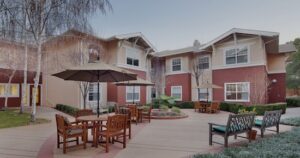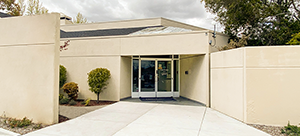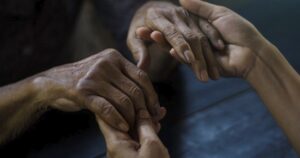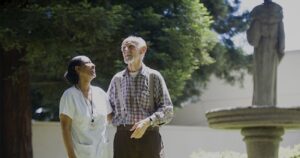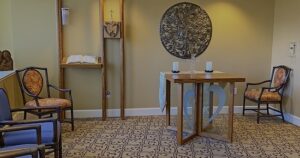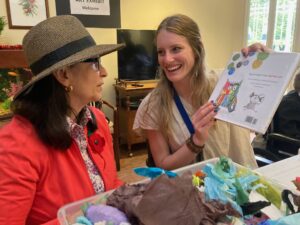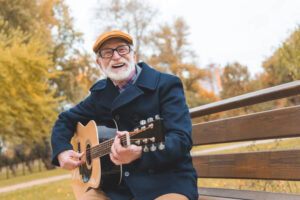A resident art project represents the best of Elder Care Alliance’s memory care communities.
A very special mural welcomes anyone who enters the BridgeHaven memory care neighborhood at AlmaVia of San Rafael. Ten residents with a flair for color and creativity created the mural and an accompanying piece of art.
More than a project to keep residents engaged and beautify the space—though it accomplishes both of these things and more—the mural is representative of Elder Care Alliance’s holistic approach to memory care. Involving residents in making choices about their environment is an important part of the overall care plan, says Erin Partridge, MA, ATR, RYT, Art Therapist and Life Enrichment Coordinator at Mercy Retirement & Care Center. “It also brings their voices out from behind the door of the memory care program and into the rest of the community,” Partridge says.
“We created the piece on thin wood veneer over two sessions, and the design was unstructured. I didn’t come in with a theme. Instead, it evolved from the residents’ color choices and our conversations as we worked on it,” says Partridge.
One resident artist sat with her daughter while working on the mural. She did not speak, but every so often looked up, smiled at her daughter, then went back to working on the art. She was fully engaged in her project. Partridge hopes the mural will continue to be a point of engagement for the residents. “It can be a conversation starter, a way for families to interact with their loved ones and a warm invitation into BridgeHaven,” she says.
Another resident did not make many additions to the mural, but she stayed for the entire session. “I’ve seen this so often, where residents who do not necessarily engage in active art-making are very engaged in the process of a piece being created,” Partridge says.
Memory Care and Art Therapy
There’s research supporting the increased engagement that Partridge sees in residents. Studies suggest that art therapy engages attention, provides pleasure and improves neuropsychiatric symptoms, social behavior and self-esteem. In addition, people with dementia who participate in such activities may be less likely to need psychiatric medication.
Dr. Zachary Miller, M.D., assistant professor of neurology at the University of California San Francisco Memory and Aging Center, says the arts are accessible to individuals with dementia, who may be hesitant to join a conversation, afraid of embarrassing themselves. But with an art project, people are putting themselves out there, leaving social stigma behind. “The arts are personal and entail [using] the kind of brain function that remains intact when memory or language fails,” Miller says.
The idea for the mural and the painting arose from several Elder Care Alliance leaders who wanted to allow residents an unstructured experience that would inspire free expression and creativity. “This project is the Elder Care Alliance experience at its best—our staff engaged with our residents, supporting purpose and passion in their lives,” says Julie Podewitz, Vice President of Sales and Marketing. Now that expression of passion and creativity is on display, offering residents, staff and visitors joy and inspiration.

